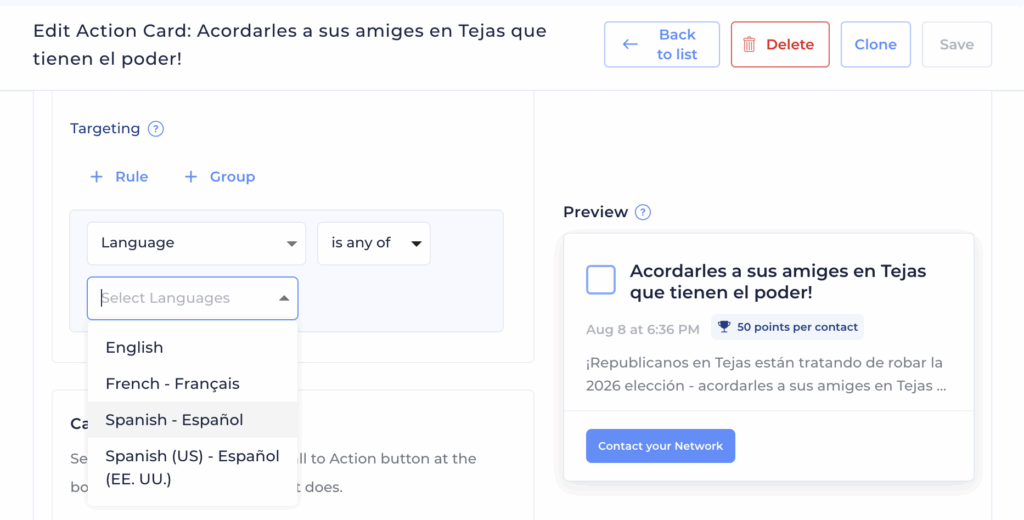America’s diversity is our greatest strength—and your campaign’s greatest opportunity! At Reach, we believe that effective organizing means making sure that every volunteer and every voter can engage in their native language. After all, Reach was born in Queens, NY, where more languages are spoken per capita than anywhere else in the world, so we know firsthand how essential this is.
We’ve built Reach with powerful features that give you the flexibility to ensure your users and the folks they’re reaching receive communication that is clear, familiar, and culturally appropriate.
Flexible Interface: Speak Your Users’ Language
Your volunteers should feel comfortable and confident using the tools you give them. We make it easy for them to choose their preferred language in the app:
- Pre-Translated Interface: The entire Reach user interface is already available in Spanish and French. Your users can simply select their preference in their profile.
- Custom Translations: For any other language, we offer a portal where your team or a vendor can translate the Reach interface. We can also customize Relationship Types into translated versions upon request.
The Right Message, to the Right Person, in the Right Language
Localization is key to all successful campaigns. Reach’s powerful filtering and targeting tools ensure your messaging is delivered where it will be most effective.
Targeting Your Users

If you have a multilingual volunteer base, you can structure your campaign to support them perfectly:
- You can target Action Cards and Push Notifications based on language
- When you create the Action Card, go to Targeting and choose language
- Now everyone who has chosen that language for their Reach interface will see those Action Cards and receive those Push Notifications
- User Groups for Language: Want to target even more? Create dedicated User Groups in Reach for volunteers working in a specific language (e.g., “Vietnamese Canvassers”).
- Localized Content: Once those groups are set up, you can create and share language-specific versions of all your core campaign materials, including:
By targeting this content to the appropriate User Group, you ensure your volunteers always see the material they need in the language they’re using in the field.
- In-App Communication: Each User Group can get its own Team Chat channel, allowing volunteers and organizers to communicate in their preferred language for real-time support.
- Admin Filtering: You can easily filter your user list in Users Admin by their interface language, making it simple to add them to the correct language-specific User Group.
Targeting Your Voters
You can use the data you collect in Reach to make sure voters or members are contacted in the language they prefer:
- Survey Questions and Tags: Use a Survey Question or Tags to record a voter’s preferred language.
- Targeted Contact Cards: Then, use this data to filter Contact Action Cards. This ensures your volunteers are prompted to contact specific voters with content (like a Spanish-language script or a Vietnamese-language video) that is tailored to their language of choice. Hint: If you choose to use Survey Questions to record the language, consider also making a smart tag based on that survey question to allow Network filtering.
Best Practices for Authentic Translation
Simply translating words isn’t enough; your message needs to be linguistically sound and culturally appropriate. Here are our top tips for delivering authentic, high-impact translations:
- Prioritize Meaning Over Words: The translation must focus on the overall meaning, tone, and intent of the source text, not on a literal word-for-word conversion. We’re looking to communicate to the voter with language and content that resonates with them.
- Target Your Audience: Every language has national, regional, generational, and cultural nuances. Your translation should be geared toward your main target audience—for instance, the Spanish spoken in a particular neighborhood.
- Avoid the Jargon Trap: Try to avoid idioms, slang, and complicated jargon in your source text, as these are notoriously difficult to translate accurately. And sarcasm? Forget about it!
- Give Context: Always provide your translator with the context and purpose of the text, including the intended audience and where the message will be used.
- Use Native, Expert Speakers: It’s a best practice for your translators to be native speakers with cultural and/or subject matter expertise.
- Get a Second Set of Eyes: Whenever possible, have a second native speaker review and check your translations for accuracy and cultural context.
- Refine with User Feedback: The field is your ultimate test! You can use User Surveys and feedback on your Content Assets in the Reach app to refine your translations based on what works for your Users.
With Reach’s language support, you can ensure your message cuts through the noise and is amplified by trusted messengers in every community. Are you ready to see the exponential reach of truly inclusive organizing? Contact us at [email protected]!